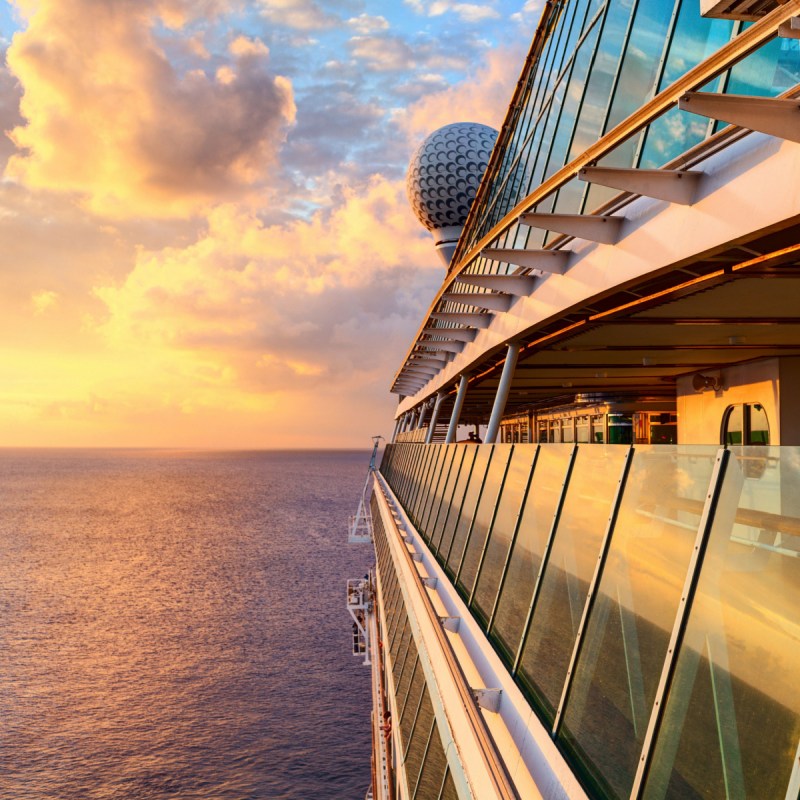
The year was 1995. It was my first time cruising a multi-port itinerary and my first time being in the Caribbean. I was almost in a state of disbelief that my wife and I were actually in the Caribbean. Yet, as excited as we were about the trip, it was tempered somewhat by what we didn’t know about such cruises.
All in all, it was a wonderful, unforgettable trip. Here are some of the things I learned on that cruise nearly 30 years ago; things that I have applied to all of the cruises I have taken since then and still follow to this day.

1. Weather May Affect Itineraries
Just because you booked a fabulous Caribbean cruise that you spent 6 months planning doesn’t mean Mother Nature will get the memo. Remember, Mother Nature is in charge, not the ship’s captain, and not you, no matter how much you are looking forward to your cruise.
As massive as some of these modern cruise ships are — Royal Caribbean’s Icon of the Seas, scheduled to make her maiden voyage in 2024, will be 1,200 feet in length, displace 250,000 tons, and carry 7,600 vacationers — even they must yield when Mother Nature decides to assert herself.
We experienced this first hand when our itinerary on that ‘95 cruise was altered due to the devastating effects of Hurricane Marilyn. We could not go to St. Thomas or St. Maarten. Instead, we were routed to St. Croix and St. Lucia.
The experts at the cruise line’s headquarters on land constantly monitor conditions. They will direct ship captains to navigate around storms, or sail to alternate islands to keep passengers safe and out of harm’s way. In rare circumstances, the sailing may be canceled completely.
It is not uncommon for Caribbean itineraries to be altered to avoid storms during the 6-month hurricane season, which the U.S. National Weather Service says runs from June 1–November 30. Now that I know when the region’s hurricane season is, if I book a cruise during this time, I accept the risk.
Pro Tip: Purchasing travel insurance is something you should consider. Some policies have a “cancel for any reason” provision. These plans cost more but they will give a full refund if you decide to cancel.
2. A Cruise Director Can Make An Ordinary Cruise Extraordinary
Cruise directors can tell you a lot about the options your cruise line offers. They can also tell you almost everything you want to know about your cruise.
Greg Kneale, former cruise director (CD) at Carnival Cruise Line, set an astronomically high bar. Other CDs have said as much. The enthusiastic information he gave during our cruise was spot on. The shows he hosted elicited uproarious laughter from the audience. Because we met him in this way, we paid even more attention to the announcements he made. We looked forward to the onboard experiences he talked about.
On the other hand, I’ve been on a couple of cruises on different cruise lines since then where we never saw the CD during the entire cruise. We only heard them making announcements. Consequently, our onboard activities were somewhat lackluster.
Kneale offered a great insight: Cruises are like a sampler; you get just a taste of the destination. If you like the island(s), you can go back for a longer stay on your own. This is especially true on longer, port-intensive Caribbean itineraries that tend to visit several islands. I’ve taken that wisdom to heart and have had deeper experiences when revisiting my favorite Caribbean islands.
Pro Tip: Find out who the CD on your cruise will be, then follow them on social media. They may post timely information about the islands you will visit.

3. Stateroom Location Is Important
One reason we got such a great deal on our 1995 cruise was the location of our cabin, or stateroom as they’re called now. It was an inside stateroom right above the thrusters. No need for an alarm clock because the rumbling thrusters announced our arrival into port each morning when they fired up.
Thrusters are a propulsion system that reduces or eliminates dependence on tug boats to nudge ships into and out of port. Modern ships use Azipods®, independent propulsion units that can be operated individually, swivel 360 degrees, and are much quieter.
After that experience, I learned to look at the ship’s layout and choose staterooms carefully. You can look these up on your cruise line’s website. The ship’s diagram will also show the location of everything else on board. I try to avoid high traffic and noisy areas like the theater, nightclub, dining areas, and promenade deck.
Though the larger ships have stabilizers to smooth out all but the roughest voyages, some passengers do get seasick. If that is you, select a stateroom closest to the middle of the ship and on one of the lower decks.
4. Try The Ship’s Destination-Themed Cuisine
If you’re not up to trying the local food on the islands you visit, or didn’t have an opportunity, the ship may serve destination-themed meals you should try. It is a safe way to find out if you like a destination’s cuisine or not, without having to commit to buying a full meal.
One night on the ’95 cruise, the main dining room featured jerk chicken. It was my first introduction to the dish. Sampling it led to a desire to try jerk chicken again, and an attempt to try to cook it at home. Seven years later, I found myself in Jamaica and couldn’t wait to try jerk chicken there. I’ve since found a few restaurants in the Los Angeles area that serve Jamaican food that tastes just like what I had in Jamaica.

5. Meet The Crew
Treat the crew like people, not servants. That should go without saying, but there are endless accounts on cruise lines’ social media channels of disrespectful guests.
Try learning a word or two in a crew member’s native language. (Their name tag usually shows their home country.) Crew member contracts can be several months long and they are away from their homes and families for that entire time. In some cases, your greeting may be the only time they hear their language spoken.
Even before our cruise began, we were given a tip by a crew member we met. Our flight into Puerto Rico arrived early in the afternoon and we had several hours before the ship departed. After checking in, we asked one of the crew members what there was to do while we waited. He suggested visiting the nearby Castillo San Felipe del Morro. He said it was within walking distance and told us exactly how to get there and back. We explored the fort, learned a bit, and made it back to the ship with plenty of time before departure.
Later during the cruise, after bumping into one of the crew members several times, we saw him in Barbados preparing to go for a run. We had a brief conversation about where he runs and he recommended some things to do in Barbados. On a later cruise, talking with a crew member from Indonesia led to a recommendation for a fantastic restaurant in Aruba. Speaking with a crew member from South Africa led to a wonderful tour of a bird sanctuary in Trinidad that I never would have considered visiting before meeting her.

6. They Have Shore Excursions
My first reaction when we learned the cruise offered shore excursions was, “They have those?”
I have to be honest: I didn’t know they had shore excursions. This was back in the mid-1990s, pretty much pre-Internet. At that time, there were only pamphlets. You went into the theater on board where someone from the shore excursions team gave a talk about the tours that were available. You marked your pamphlet with which one(s) you were interested in and signed up.
Today, you can sign up for an excursion online, in advance, and as soon as you’ve booked your cruise. I’d advise doing this, especially for the more popular excursions. Depending on the island, excursion options can range from few to many. Don’t get left out because you waited too long. That happened to me in 2018 when I couldn’t find a way to get to all of the places I wanted to visit during the short time I had in Curaçao.
Companies like Viator and Tours By Locals, among others, also offer shore excursions, providing even more options while you are in port. I’ve used both of these tour operators.
Pro Tip #1: Cruise ships visit dozens of islands in the Caribbean. Take a few moments before your cruise to learn a bit about each island on your itinerary. This will help make choosing the perfect shore excursions a little easier.
Pro Tip #2: Don’t be a pier runner, or worse yet, miss your ship altogether. Book an excursion through the cruise line, or make sure any excursion you book on your own has a guarantee to return you to the ship on time. Caribbean islands may be relatively close to each other, but getting from one island’s port to the next, if you miss your ship, can be quite an ordeal.
7. They Have Post-Cruise Shore Excursions
On a similar note, we learned there were post-cruise shore excursions that drop you off at the airport after your tour. If your flight does not depart until later in the afternoon or evening, I highly recommend looking into a post-cruise excursion. It allows you to spend the time exploring the port city instead of trying to find transportation to the airport, then spending several boring hours at said airport waiting for your flight.
Think of it as another port of call on your cruise, but one that includes an airport transfer at the end. This is particularly beneficial for Caribbean cruises that depart from Florida ports (Orlando, Ft. Lauderdale, or Miami), and especially from San Juan, Puerto Rico, and Barbados. We took this route on our 1995 cruise and got to see a bit more of San Juan, Puerto Rico, before catching our flight. By taking advantage of post-cruise shore excursions on subsequent cruises, we’ve been able to explore Miami, San Juan, and most recently, Barbados.
With what I’ve learned, I now have more confidence going into each cruise. I now make more meaningful connections to each place I visit. The cruise industry is constantly changing, but the things I learned on that Caribbean cruise almost 30 years ago continue to serve me well.
